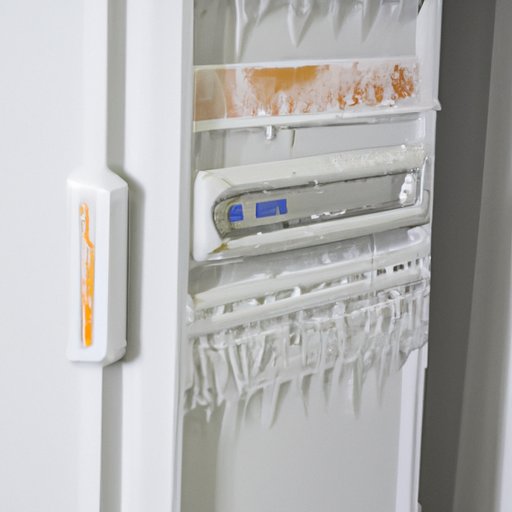Introduction
It’s a common sight in many households—frost buildup in a freezer. But what causes this buildup of frost? In this article, we’ll delve into the science of freezer frost to uncover what causes it and how you can prevent it from forming in your own freezer.

Exploring the Science of Frost Formation in Freezers
To understand what causes frost in freezers, it helps to first look at how cold temperatures lead to frost build up. When temperatures reach below freezing inside a freezer, water vapor from the air condenses and freezes onto the walls of the freezer. This forms a layer of ice that gradually builds up over time. There are two main types of frost that can form in a freezer: hoar frost and rime frost.
Hoar frost is the most common type of frost found in freezers. It occurs when the air temperature inside the freezer drops below freezing and moisture present in the air condenses onto the surfaces of the freezer. Hoar frost usually appears as a white dust-like substance on the walls and shelves of the freezer.
Rime frost, on the other hand, forms when the air temperature inside the freezer is slightly above freezing. In this case, the moisture in the air condenses and freezes onto the walls in the form of small droplets. Rime frost often appears as a thicker, more solid layer of ice than hoar frost.

Investigating the Reasons Why Frost Forms in Your Freezer
Now that we’ve looked at the science of frost formation in freezers, let’s explore the reasons why frost can form in your own freezer. The two main factors that contribute to frost buildup are moisture and humidity levels.
Moisture is the key factor in determining whether or not frost will form in your freezer. Moisture is present in the air, and when the temperature inside the freezer drops below freezing, the moisture condenses and freezes onto the walls and shelves. The higher the level of moisture in the air, the more likely it is that frost will form in the freezer.
Humidity levels also play an important role in frost formation. High humidity levels can increase the amount of moisture in the air, making it more likely for frost to form. On the other hand, low humidity levels can reduce the amount of moisture in the air and make it less likely for frost to form.
Preventative Measures to Avoid Freezer Frost
Now that we’ve explored the science behind frost formation in freezers, let’s look at some preventative measures you can take to avoid frost buildup in your own freezer. The first step is to keep moisture out of the freezer. Make sure to wipe down the walls and shelves of the freezer regularly to remove any moisture that may have built up. You should also make sure that food items are properly sealed before putting them in the freezer to prevent moisture from seeping in.
Another important step is to reduce the humidity levels inside the freezer. To do this, you can use a dehumidifier to draw out excess moisture from the air. Additionally, you can make sure to keep the door of the freezer closed when not in use to prevent moisture from entering. Finally, you can open the door only when necessary to reduce the amount of time the freezer is exposed to humid air.
Conclusion
In conclusion, frost buildup in freezers is caused by cold temperatures, moisture, and humidity levels. To prevent frost from forming in your freezer, it’s important to keep moisture out of the freezer and reduce the humidity levels inside. By following these tips, you can help ensure that your freezer stays frost-free.


